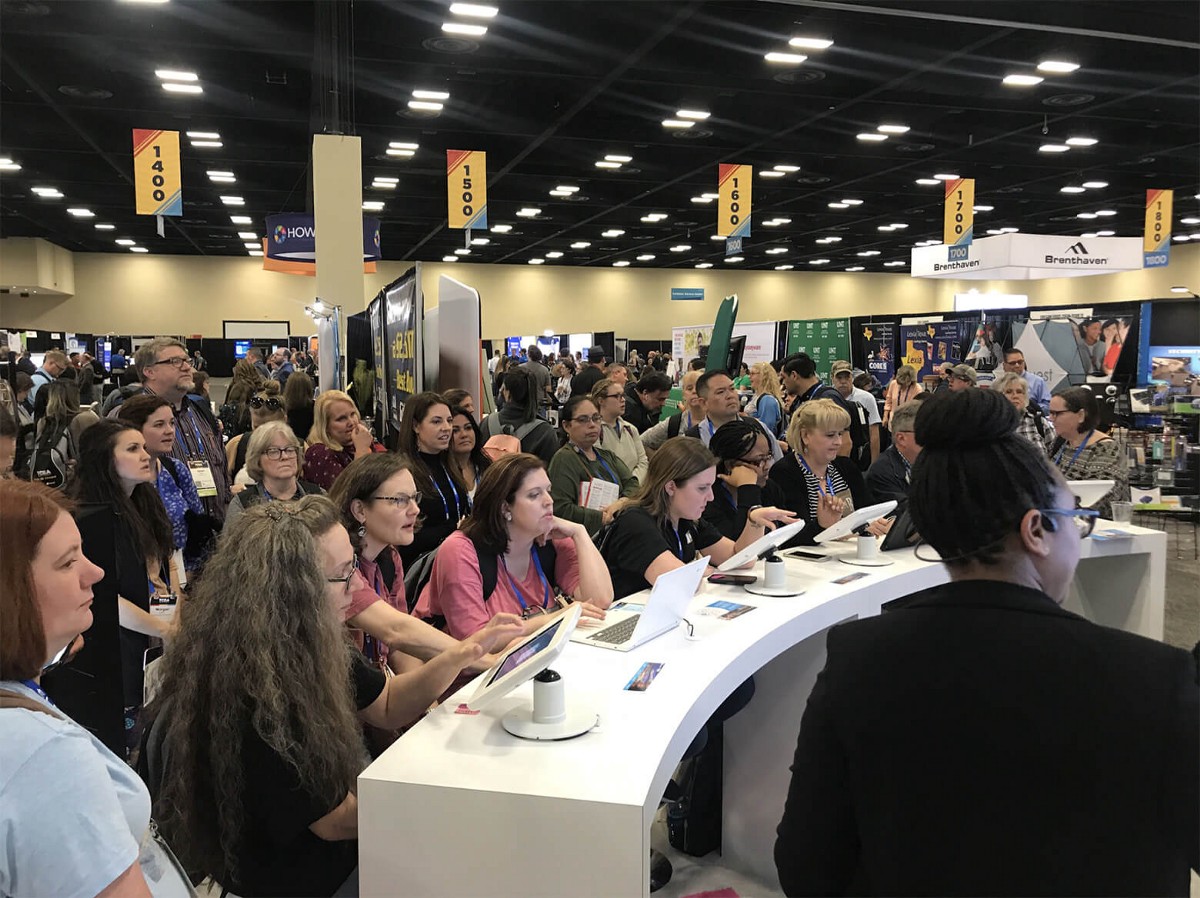Attending, exhibiting, sponsoring or speaking at an education industry or association conference? Here’s a quick set of tips for startups both before and during the event.
Remember: A conference “presence” doesn’t have to be an exhibit booth. It can be walking the show floor to understand buyers and the competition, sponsoring a specific program at the event, hosting an off-exhibit-floor meeting room or speaking on the conference program. Consider them all.
Picking a conference
- For sales leads (instead of just awareness), choose events that are:
- Targeted. Exhibit/sponsor only at conferences that primarily attract your target audiences/personas.
- Local/regional. Avoid exhibiting at or sponsoring conferences that are national in scope unless awareness is your primary objective. For sales leads, local or regional events that also are targeted are a better choice; at smaller events, there is more opportunity to mingle/network with prospects.
- Speaking/presenting. If sponsoring, preference should go to event sponsorship levels that give you a chance to speak, as a sponsor, whether it’s an introduction to a plenary session or a sponsor session. It is not worth paying extra to be a logo sponsor at a breakfast, on a lanyard, or on a tote bag. Nobody remembers those.
- You aren’t in the conference or trade show game for corporate ego.
- You aren’t in the free product business (unless, of course, you’re an edtech startup that exhibits at big shows to get teachers to sign up and try it for free — in that case, read this post from Nearpod co-founder Guido Kovalskys).
- Overall, you should go to conferences to increase awareness, and ultimately to generate new leads, move existing leads along, and to touch base with current customers for retention.
Selection criteria
- Attendance density of a target audience. The fewer non-target attendees, the better. Are you looking for early adopter teachers, school principals, district IT leadership, curriculum decision makers or administrative and business office staff? Ask about the attendee makeup of the event and the percentage of your target audience in it.
- Ability to meaningfully interact face-to-face with members of a target audience. A small event with few exhibitors and all targeted attendees beats a large general event, even if it has more target attendees in absolute numbers; you won’t waste time determining who you should be speaking with. (Consultant Doug Roberts has a few wise things to say about alternatives to major trade show booths.)
- Attendees who are likely to include existing customers who can act as ad hoc referrals.
- Remember: Lead gen is the purpose of targeted conferences; awareness/branding is the purpose of larger trade shows
Sponsorship level criteria
- Lowest level where there’s an exhibit space/table, speaking opportunity (intro or session), and attendee list with email addresses. If you can’t get all three, prioritize good exhibit space/table and speaking opp.
- Go in small for new-to-you events to test the waters the first year.
- Never automatically become the top level, blow-out sponsor because then the organization expects you to do that every year, and won’t woo you as hard to stay involved.
- Don’t sponsor meals, breaks, giveaways, handouts or anything additional if it doesn’t come with a speaking opp that you couldn’t get with an exhibit space/table. Again, no one remembers whose logo is on the tote bag or coffee sign.
Promotional item criteria
- Lightweight, useful, with high perceived value—it should be able to be used frequently after the conference to act as a reminder of the company.
- No food items (say, cookies) as a primary promotional item. Once eaten, the company is immediately forgotten.
- Keep the actual dollar value of any promotional item low, even if it’s for select prospects or customers. That’s not just for budget reasons. Public school employees are government employees and generally cannot accept high-value “gifts.”
- Swag (or giveaways) should never become the reason someone stops by the exhibit/table. It’s a “thank you” for stopping by, not the purpose of the booth itself.
Success criteria
- Ideally, at least 10X in the value of new business (e.g. annual subscriptions) of the hard sponsorship/fees cost. Existing deals in the pipeline should not be counted as “new.”
- Also consider the value of moving along deals already in the pipeline.
- Having a presence for existing customers is a nice-to-have, not a must-have.
Exhibiting at a conference
In the exhibit (booth or table)
- Do engage as people walk up. CTOs at a CoSN focus group said they visit vendor booths because of engagement and eye contact.
- Do walk the exhibit hall when not on booth duty to see what competitors and others are doing, who has crowds and who doesn’t, and what appears to be hot at the event.
- Do use lead capture software or another structured technique so you don’t have to rely on your memory alone later.
- Do pace your swag and collateral. Refresh what’s on the table as you go so it lasts, and keep the table neat.
- Don’t stare at your phone or laptop when attendees are in the exhibit area. It sends a subtle “don’t bother me, I’m busy” vibe.
- Don’t eat in the booth or put your food or drink on the exhibit table. Step out of the booth if you need a bite.
- Don’t leave the exhibit unattended during exhibit hall hours. You never know when that sale only had a second to stop by and no one was there. If you need a break, please make it quick.
- Don’t let your laptop go to sleep if you’re running the monitor loop. Disable your sleep settings.
In a program session
- Do be prepared if your company gets a positive plug in someone else’s session. One method is during the Q&A, stand up and thank the presenter(s) for mentioning your company and say you’ll be glad to stay afterwards to answer anyone’s questions. Keep it brief and non-promotional.
- Do listen and engage with other attendees as a peer. You’re there to learn, just as they are, and having them see you as a colleague is great relationship building.
- Don’t overtly promote your company in someone else’s session. An unrelated plug in Q&A is usually very obvious to everyone except the person making it. But saying you’re “with [company]” when introducing yourself to ask a question in Q&A is totally fine.
Moderating/speaking at a conference
If you’re fortunate enough to moderate a conference program session, prepare in advance.
(Disclaimer: This approach was refined and successfully applied by the author at dozens of major conferences for discussion-based, lively sessions without formal presentations.)
Before the panel
- Review the conference session description and any supporting materials submitted. Learning objectives, panelist bios, etc.
- Introduce yourself to panelists, and the panelists to each other, by group email, restating session description, length, format, date/time, and location. Indicate you’ll be setting up individual calls or a group call for prep.
- Schedule either a 30-45 minute group prep call (hard) or 15-minute individual calls (easy) and verbally cover the critical basics. Include description, date/time, location. Detail the format: Ideally, a discussion among panelists, no presentations, slides only for illustrating key points with data. Ask what “hot topics” the speaker wants to make sure are covered.
- After the final call, send an email to all the panelists again restating the basics, plus prep. List a single provocative opening question you’ll be asking all the panelists to briefly address. Provide a bullet-pointed list of topic areas (not questions) you may cover, reinforcing that not all panelists may be asked about each area, and not all topic areas may be covered, or covered in the order presented. The list is to give them something to think about, not to prepare a script.
During the panel
- At the panel, the moderator should feel free to ask follow up questions, interrupt politely for clarification, and direct questions to individual panelists (not every question to all panelists).
- Briefly introduce the panelists with a sentence or two; don’t have them introduce themselves so the introductions don’t cut into discussion time.
- The moderator is the audience surrogate and advocate: Ask what they want to know.
Author Frank Catalano is a former chief marketing officer and senior executive for education technology companies including ParentSquare, Pearson, SchoolMessenger and ProExam, as well as a veteran edtech industry strategist, analyst and advisor. His technology and business writing has appeared in EdSurge, GeekWire, Seattle Weekly, NPR/KQED MindShift and more.
Copyright © 2023 Frank Catalano


